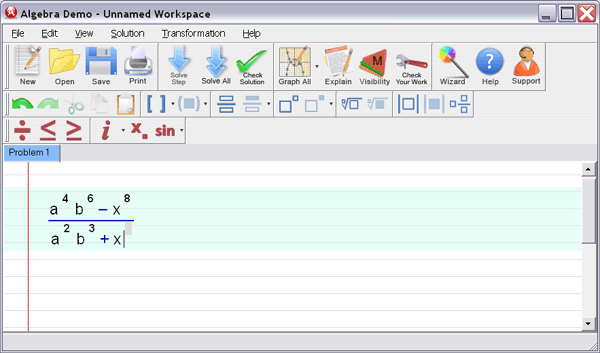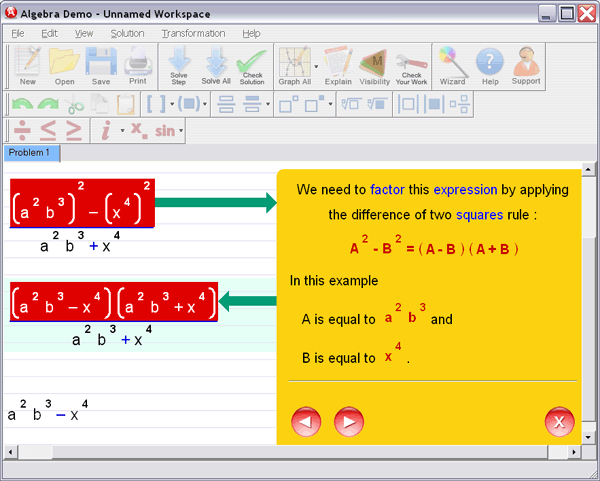Fractions,Decimals,and Percents
Materials
| Facilitator |
Transparencies
(English & Spanish) |
• Tangram pieces (one
set for the overhead projector)
• A supply of newspapers and magazines
• Three flip chart sheets (or a long strip of butcher
paper, approximately 6 feet by 3 feet) |
BLM 1: NCTM Learning Principle
BLM 2: Math Class Web |
| Participant |
Handouts (English & Spanish) |
• Tangram pieces (one
set per participant to take home)
• 5 x 8 index cards (one for each participant)
• 3 x 5 Post-it® notes (one pad for each table) |
One set per table
BLMs 3-8: Tangram Pattern Sheets 1-6
One per participant for home
BLMs 3-8: Tangram Pattern Sheets 1-6
BLM 9: Bringing Mathematics Home 1 |
Activities
| Preparation of Classroom |
Notes |
| Create
Fraction -Decimal-Percent Charts. Use three flip chart sheets or a long
strip of butcher paper divided into three sections. Label the sheets or
sections Fractions, Decimals, and Percents. The charts will be used
during the course and more information will be added to them in
subsequent sessions. |
At the conclusion of this class
session, plan to roll or fold the charts in a way that preserves the
items posted and bring them to the next class session. |
| Getting to Know Each
Other (10-15 minutes) |
|
| 1. Introduce yourself
and tell a little bit about your professional and personal background.
If you have children be sure to talk about them. Parents will feel
comfortable relating to you as a fellow parent.
2. Tell participants that this course is about
fractions, decimals and percents and is designed to serve three
purposes:
• To expand their understanding of mathematics
• To experience mathematical activities that can be used with their
children at home
• To have fun!
3. Tell participants that the course will be more
enjoyable if we get to know one another and learn each other’s names.
• Give each participant an index card.
• Ask each participant to fold the card to form a tent.
• Ask them to write their name in large letters and to draw their
children on the card. (See sample in the notes to the right.)
4. After the name cards are completed, ask
participants to introduce themselves and talk about their children with
others at their table. |
Allowing time for personal
introductions is important because it helps set a friendly, relaxed tone
for the class.

The name cards should be collected at the end of
each class and handed out at the beginning of each session.
Encourage parents to talk about their children,
telling their ages, personalities, etc. After all, their children are
the reason they are here! |
| Tangram Explorations
(40-50 minutes) |
|
Tangram Puzzles
1. Distribute a set of Tangrams to each participant. Give Tangram
Pattern Sheets 1-6 to each group. Explain that tangrams are commonly
used in school mathematics.2. Ask
participants to work with a partner to try to use all seven pieces to
form each of the shapes shown on the Tangram Pattern Sheets. Let them
know that it is not necessary to solve all of the puzzles , but that they
should try several of them.
The Value of a Tangram Piece
1. Tell participants that they will now do another activity with the
tangram pieces. Say:
• Imagine that a person could buy the whole set of tangrams for $8.00,
or just buy individual pieces. What would be the value of each of the
individual pieces?
• Assume that the value of a piece depends on its size (area) in
comparison to the other pieces.
2. Encourage participants to work with a partner
so that they have the opportunity to talk about their thinking. If some
groups complete the task quickly, see notes for extension questions.
3. Solutions to tangram problems are provided on
page 7.
Processing
1. Have several participants present the reasoning they used to
determine each piece’s value. Encourage them to use the overhead tangram
pieces when demonstrating their reasoning. As participants share, record
the mathematical language they are using. They might be using terms such
as parts, half, twice as much, compared to, fraction of, percent, or
ratio.
2. It is important to validate every participant’s
contribution as they complete their sharing by pointing out the strategy
that they used. After all the volunteers have presented, celebrate the
variety of strategies that have been shared.
3. If many groups solved the $12, $1.60, and $1.00
problems.
Ask:
How did the solution to the $8.00 problem help you
to solve the other problems?
4. After participants have shared, point out that
the problem was solved in many ways, but in all cases they were using
the ideas of fractions, decimals, and percents. Participants were
considering the relationship of the parts to the whole and of the parts
to each other. This kind of thinking and reasoning is basic for
understanding fractions, decimals, and percents.
5. Take a few minutes to explain the use of
manipulatives in today’s classroom. It might be appropriate to bring in
a sampling of the manipulatives that will be used during this course.
Research has shown that manipulatives can be a very effective aid in
learning mathematics.
6. Let them know that in the next few classes they
will continue to use manipulatives and problems to help illuminate more
ideas about fractions, decimals, and percents.
• Sessions 2 – 4 will focus on fractions,
• Sessions 5 – 6 will focus on decimals,
• Sessions 7 – 8 will focus on percents. |
By providing only one set of the
Tangram Pattern Sheets 1-6 per table, the activity promotes interaction
and conversation. Tangrams are believed to
have originated as a puzzle in China around 1800 .
During group work, be sure to walk around and
listen to the conversations in order to know what the participants are
thinking.
If some groups complete this task quickly, pose
these additional challenges:
• If the completed shape is worth $12, what is the value of each piece?
• If the completed shape is worth $1.60, what is the value of each
piece?
• If the completed shape is worth $1.00, what is the approximate value
of each piece?
Participants may be reluctant to come to the front
of the room to share. Be sure to offer support and acknowledgement to
those who volunteer. Allow partners to come to the overhead together and
offer your assistance to them as they present.
This is an appropriate time to take a short break,
if desired. |
Fractions, Decimals and
Percents in Daily Life
(20-30 minutes)Applications in daily life
1. Remind participants that this course is focused on the mathematical
ways we represent parts of things using fractions, decimals, and
percents. These topics are heavily represented at the elementary and
middle school level. Explain that one reason for this emphasis is the
practical usefulness of fractions, decimals, and percents in daily life.
Say:
The object of this next activity is to brainstorm
lots of everyday uses for fractions, decimals, and percents
2. Ask for volunteers to share places they use
fractions, decimals, and percents at work or at home. After a few
examples have been shared, ask participants to generate a short list of
additional examples at their table. Say:
We will be sharing our ideas soon, but before we do, let’s expand our
lists by looking through some magazines and newspapers for more ideas.
Newspaper Search
1. Hand out newspapers and magazines and allow participants to cut out
additional fraction, decimal, and percent examples.
2. If their list contains additional examples that
are not found in the paper, they may write each idea on a Post-it®.
3. Have participants work in groups to collect
examples.
Sharing ideas
1. After 5 minutes, have each group post their examples on the
Fraction-Decimal-Percent Charts, while sharing what they have found. If
an idea has already been shared, ask them to state it again and post the
clipping or Post-it® note on top of the others with the same idea. This
will indicate which uses of fractions, decimals and percents are the
most common.
2. Once all items have been posted, ask
participants to look for ideas that are common to the three lists. For
example, many examples will likely have to do with making comparisons,
measurement, and money. Ask:
Why do you suppose that fractions, decimals and percent are often taught
together? |
This section will be using the
Fraction, Decimal, and Percent charts that you set up before class.
Encourage participants to consider the things they
see as they drive, watch TV, read the newspaper, go shopping, banking,
or do chores at home.
Examples:
• Interest rates
• Sports statistics
• Shopping advertisements, surveys
or graphs
• Radio station call numbers
• Stock market changes
• Cooking
• Shopping prices
Ask participants to use markers rather than pens
or pencils when writing on the Post-it® notes and to write large enough
for it to be seen from a distance.
Possible entries for the Fraction-Decimal-Percent
charts are listed on page 8. The chart made by each class should reflect
participants’ ideas. It will not be necessary to include all the items
listed on page 8.

Some reasons might include:
• They are used in similar ways as the fraction-decimal-percent chart
shows
• They are used to express a part-whole relationship
• They can be interchanged
(0.5 = 50% = 1/2). |
| National Standards (3-5
minutes) |
|
1. Display NCTM Learning
Principle transparency. Say:
• The activities of this session provide an illustration of the
direction of mathematics instruction today.
• The National Council of Teachers of Mathematics (NCTM) has published a
document called Principles and Standards for School Mathematics. |
Since this is the first class,
participants may be reluctant to share ideas with the whole class. If
this is the case, ask them to share with a partner first and then share
with the large group. |
2. Tell them that one of
the six principles described in the document is the Learning Principle.
Participants must learn mathematics with understanding, actively
building new
knowledge from experience and prior
knowledge. |
They might point out the fact that
they were actively engaged in the learning and that this session built
upon their own prior knowledge of fractions, decimals, and percents. |
| 3. Ask participants to
share ways that this class session relates to this principle. |
|
| Math Class Web (15-20
minutes) |
|
| 1. Display Math Class
Web transparency. Now the class will analyze the activities of this
session in light of the NCTM’s guidelines. |
Possible responses to the Math Class
Web are shown on page 9. |
2. Ask participants to
think about three questions regarding the learning situation in this
class:
• What was the teacher doing?
• What were the participants doing?
• How did you feel as the learner? |
It may be necessary to acknowledge
that in their own children’s experience they may not find this approach
reflected at all times . However, this is the goal set out by educational
experts (NCTM). |
3. Ask for responses as
you fill in the Math Class Web transparency. Say:
Now picture what your math class looked like when you were in school.
Ask:
• What was the teacher doing?
• What were the participants doing?
• How did you feel as the learner?4. Record
responses on the same Math Class Web transparency using a different
color pen.
5. Tell participants that one goal of this class
is to provide them with many experiences that reflect the current
approach to teaching and learning mathematics. Through these experiences
they will be better able to assist their children in learning
mathematics. |
|
| Take Home Activities (5
minutes) |
|
| 1. There are two items
for participants to take home: Bringing Mathematics Home 1 and a
personal copy of Tangram Pattern Sheets 1-6.
2. Participants will need to take a set of Tangrams
home in order to complete the Bringing Mathematics Home 1 activities.
3. Encourage participants to try at least one of
the activities listed either with their children, their spouse or on
their own |
|
| Preparation for the Next
Session (5 minutes) |
|
| 1. Collect name cards
for use in the next sessions. 2. Fold or
roll the Fraction-Decimal-Percent charts in a way that preserves the
items posted on it and bring it to the next class.
3. Save the Chart It! and bring it to the next
class. If desired, you may have the log typed and distributed to
participants at the next class. |
|
Start solving your Algebra Problems
in next 5 minutes!
 |
 |
 |
|
Algebra Helper
Download (and optional CD)
Only $39.99
|
|
Click to Buy Now:
OR
|
|
|
 |
 |
 |
|
2Checkout.com is an authorized reseller
of goods provided by Sofmath
|
|
Attention: We are
currently running a special promotional offer
for Algebra-Answer.com visitors -- if you order
Algebra Helper by midnight of
January 22nd
you will pay only $39.99
instead of our regular price of $74.99 -- this is $35 in
savings ! In order to take advantage of this
offer, you need to order by clicking on one of
the buttons on the left, not through our regular
order page.
If you order now you will also receive 30 minute live session from tutor.com for a 1$!
|
You Will Learn Algebra Better - Guaranteed!
Just take a look how incredibly simple Algebra Helper is:
Step 1
: Enter your homework problem in an easy WYSIWYG (What you see is what you get) algebra editor:

Step 2 :
Let Algebra Helper solve it:

Step 3 : Ask for an explanation for the steps you don't understand:

Algebra Helper can solve problems in all the following areas:
- simplification of algebraic expressions (operations
with polynomials (simplifying, degree, synthetic division...), exponential expressions, fractions and roots
(radicals), absolute values)
- factoring and expanding expressions
- finding LCM and GCF
-
(simplifying, rationalizing complex denominators...)
- solving linear, quadratic and many other equations
and inequalities
(including basic logarithmic and exponential equations)
- solving a system of two and three linear equations
(including Cramer's rule)
- graphing curves (lines, parabolas, hyperbolas, circles,
ellipses, equation and inequality solutions)
- graphing general functions
- operations with functions (composition, inverse, range, domain...)
- simplifying logarithms
- basic geometry and trigonometry
(similarity, calculating trig functions, right triangle...)
- arithmetic and other pre-algebra topics
(ratios, proportions, measurements...)
ORDER NOW!
 |
 |
 |
|
Algebra Helper
Download (and optional CD)
Only $39.99
|
|
Click to Buy Now:
OR
|
|
|
 |
 |
 |
|
2Checkout.com is an authorized reseller
of goods provided by Sofmath
|
|
|
 |
| |
| "It
really helped me with my homework. I was
stuck on some problems and your software walked me
step by step through the process..." |
| C. Sievert, KY
| |
| |
 |
| |
Sofmath
19179 Blanco #105-234
San Antonio, TX 78258
|
Phone:
(512) 788-5675
Fax: (512) 519-1805
| | |



